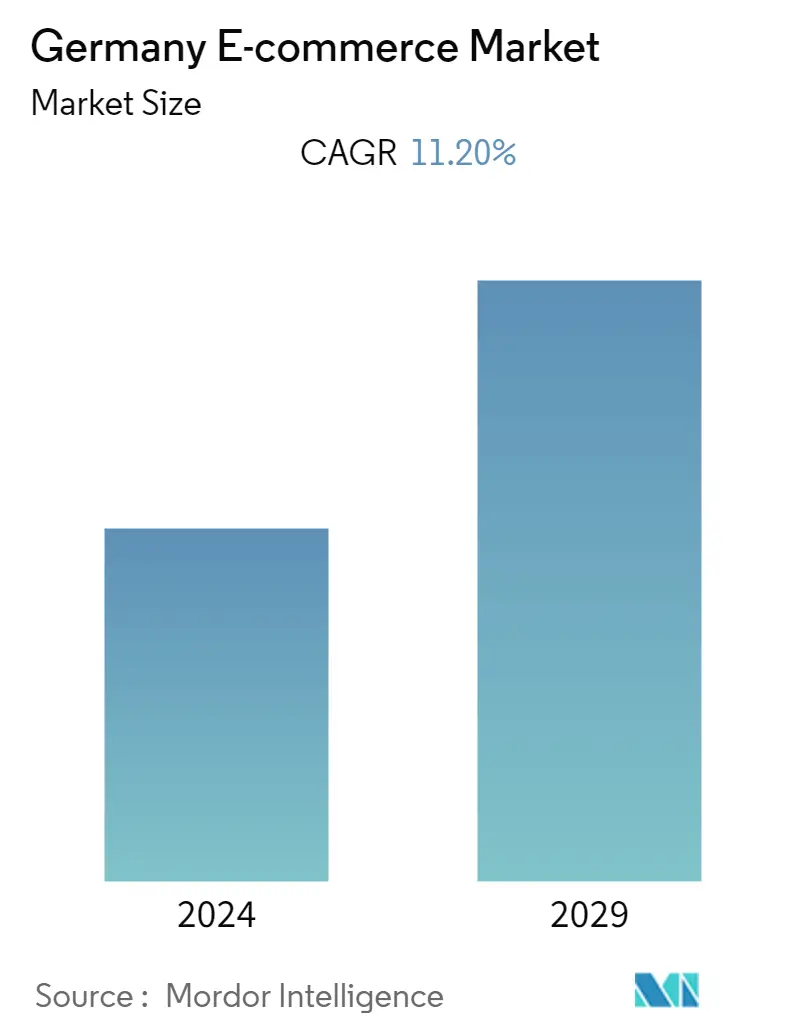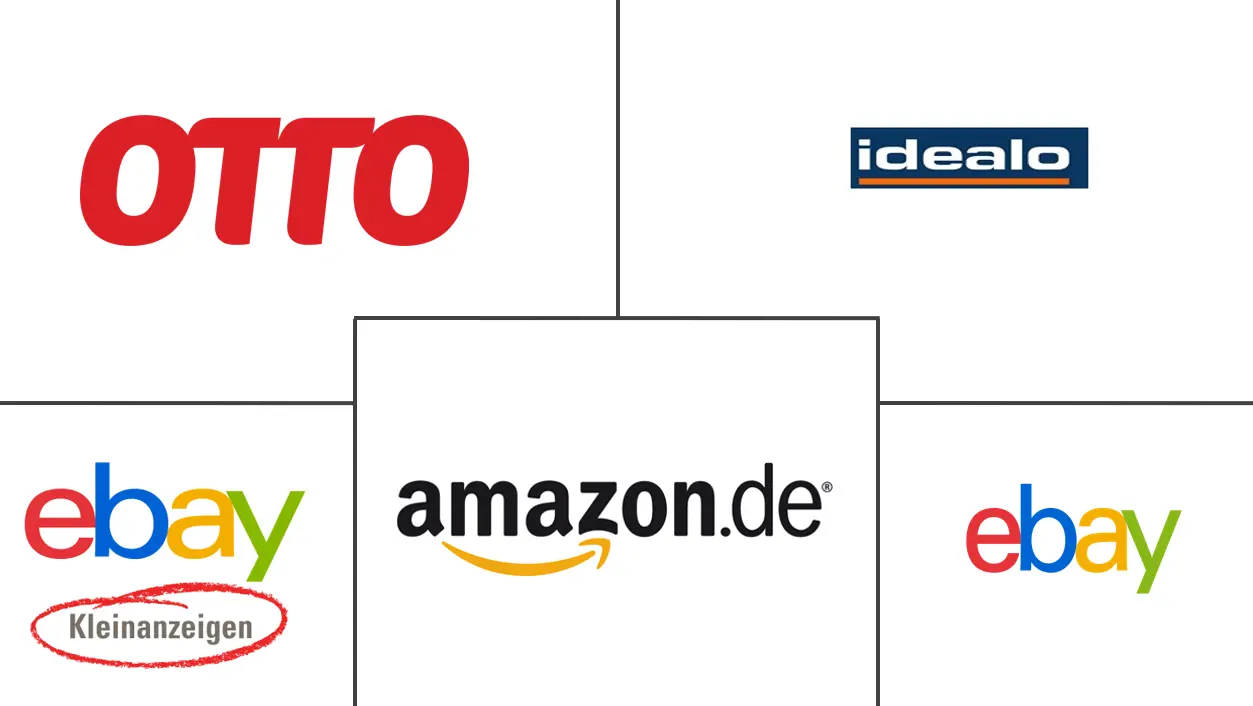Market Size of Germany E-commerce Industry

| Study Period | 2019 - 2029 |
| Base Year For Estimation | 2023 |
| Forecast Data Period | 2024 - 2029 |
| Historical Data Period | 2019 - 2022 |
| CAGR | 11.20 % |
| Market Concentration | Low |
Major Players
*Disclaimer: Major Players sorted in no particular order |
Germany E-commerce Market Analysis
The German e-commerce market is expected to register a CAGR of 11.2% from 2022 to 2027. The market is primarily driven by high internet penetration, rising urbanization, and an increase in mobile shopping.
- The high internet penetration and the increasing adoption of smart devices in the region are primarily driving the market for e-commerce platforms. Due to the rising urbanization, several conventional businesses are inclined toward e-commerce platforms to expand their consumer base and market share, control overhead costs, and improve product sales.
- Most online stores in Germany accept PayPal and credit cards as payment methods. Many websites accept bank transfers, invoice/buy now, and pay later. Online customers can cancel orders and return goods or services within 14 days, for any reason and with no justification. With so many advantages that e-commerce companies offer, the region's e-commerce market is further expected to grow over the forecast period.
- Furthermore, mobile shopping has become more prevalent in the region, and instant payments suit the needs of modern consumers. Additionally, smartphone usage is growing faster in Germany, increasing the use of e-wallet payment methods. This growth is expected to continue as retailers improve their mobile websites and provide more convenient shopping methods on mobile devices.
- However, if an e-commerce company wishes to reach potential customers in Germany via its website or web store, it must comply with some rules and regulations, such as VerpackG. According to the law, manufacturers, distributors, or importers of packaging or packaged products must contribute to the disposal costs to assume responsibility for the product and its return and disposal. The VerpackG affects manufacturers, distributors, or importers of sales packaging: packaging that typically accumulates as waste for the end consumer. This type of regulation can hamper the growth of the e-commerce market in Germany.
- The appearance of the COVID-19 outbreak and its spread across the globe has changed the lives of millions of people. During the COVID-19 pandemic, Germany was exposed to the imposition of travel restrictions, lockdowns, and shop and service points closure. Consequently, COVID-19 changed the habits of consumers as well as shopping channel preferences. The growth of online shopping reshapes the German retail market and causes companies to adapt to changed market requirements.
Germany E-commerce Industry Segmentation
E-commerce refers to the internet's commercial transaction of goods and services. These transactions are primarily conducted via various business models, such as B2C and B2B. E-commerce platforms offer advantages such as minimized inventory cost, improved profit margins, various discounts, hassle-free delivery of goods and services, etc.
The Germany E-commerce Market is Segmented into B2C E-commerce (Beauty and Personal Care, Consumer Electronics, Fashion and Apparel, Food and Beverage, Furniture and Home), and B2B E-commerce.
| By B2C E-commerce | ||||||||
| Market Size (GMV) for the Period of 2017-2027 | ||||||||
|
| By B2B E-commerce | |
| Market Size for the Period of 2017-2027 |
Germany E-commerce Market Size Summary
The German e-commerce market is experiencing significant growth, driven by factors such as high internet penetration, increasing urbanization, and the rise of mobile shopping. The adoption of smart devices and the prevalence of mobile commerce are particularly noteworthy, as they enhance the convenience and accessibility of online shopping. Retailers are increasingly optimizing their mobile websites and developing dedicated apps to cater to the growing number of smartphone users. This trend is further supported by the popularity of various payment methods, including e-wallets, which align with the preferences of modern consumers. However, regulatory challenges, such as the VerpackG, impose responsibilities on manufacturers and distributors regarding packaging disposal, which could potentially impact market expansion.
The COVID-19 pandemic has significantly altered consumer behavior, accelerating the shift towards online shopping and reshaping the retail landscape in Germany. This shift has led to a surge in online apparel sales, with e-commerce accounting for a substantial portion of total apparel sales. German consumers are known for their discerning nature, prioritizing value for money and sustainability in their purchasing decisions. As a result, e-commerce platforms are increasingly focusing on providing sustainable options and enhancing the shopping experience. The market is characterized by a fragmented landscape with numerous players, including major platforms like Amazon.de and Zalando, which continue to expand their offerings and logistics capabilities to meet growing consumer demand.
Germany E-commerce Market Size - Table of Contents
-
1. MARKET INSIGHTS
-
1.1 Market Overview
-
1.2 Industry Attractiveness - Porter's Five Forces Analysis
-
1.2.1 Bargaining Power of Suppliers
-
1.2.2 Bargaining Power of Buyers/Consumers
-
1.2.3 Threat of New Entrants
-
1.2.4 Threat of Substitute Products
-
1.2.5 Intensity of Competitive Rivalry
-
-
1.3 Key Market Trends and Share of E-commerce of Total Retail Sector
-
1.4 Impact of COVID-19 on the E-commerce Sales
-
-
2. MARKET SEGMENTATION
-
2.1 By B2C E-commerce
-
2.1.1 Market Size (GMV) for the Period of 2017-2027
-
2.1.2 Market Segmentation - by Application
-
2.1.2.1 Beauty and Personal Care
-
2.1.2.2 Consumer Electronics
-
2.1.2.3 Fashion and Apparel
-
2.1.2.4 Food and Beverages
-
2.1.2.5 Furniture and Home
-
2.1.2.6 Others (Toys, DIY, Media, etc.)
-
-
-
2.2 By B2B E-commerce
-
2.2.1 Market Size for the Period of 2017-2027
-
-
Germany E-commerce Market Size FAQs
What is the current Germany E-commerce Market size?
The Germany E-commerce Market is projected to register a CAGR of 11.20% during the forecast period (2024-2029)
Who are the key players in Germany E-commerce Market?
Amazon.de, eBay.de, eBay Kleinanzeigen, Otto GmbH and Idealo Internet GmbH are the major companies operating in the Germany E-commerce Market.

